Puget Systems Echo: Intel and AMD Showdown at 65 Watts
by Dustin Sklavos on March 21, 2012 2:35 AM EST- Posted in
- Systems
- AMD
- Intel
- Mini ITX
- Sandy Bridge
- Llano
- boutique
- Mini-Tower
System Performance
When I started testing these two systems from Puget Systems I honestly wasn't prepared for the kind of tug of war that would occur. Fundamentally, the expected results are on the page: the Intel CPU outclasses the AMD APU at every turn, while AMD's integrated graphics hardware thoroughly outclasses Intel's. I'm not going to lie either, the results are about what you'd expect. What impressed me was just how wide the gaps were. Take a look.
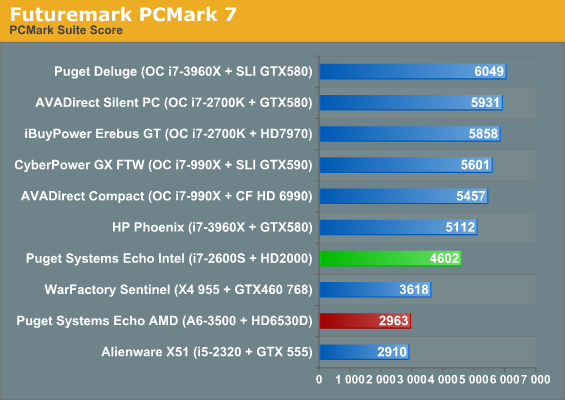
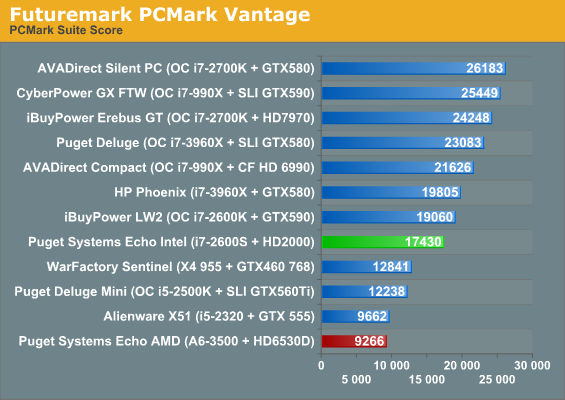
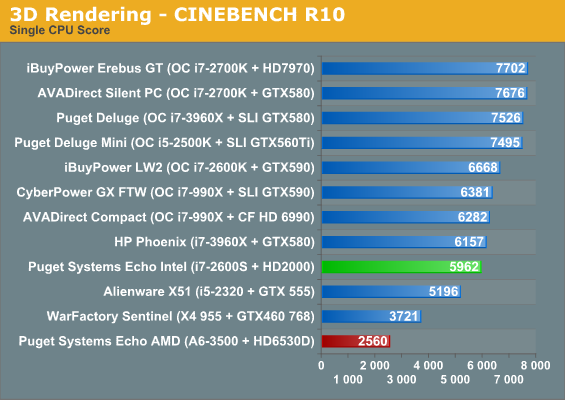
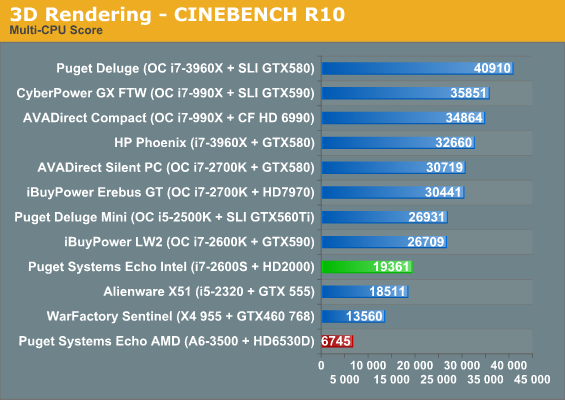


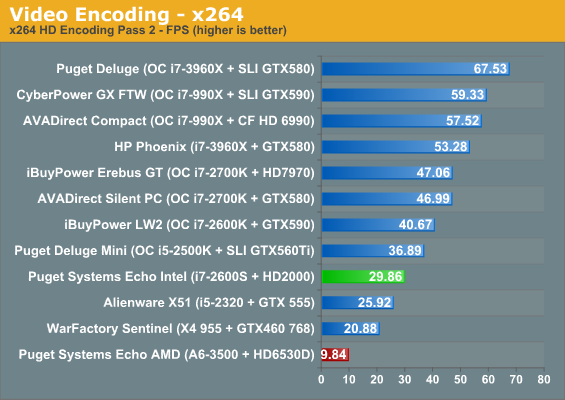
While the A6-3500's CPU performance would certainly be fine for a notebook, it's absolutely lousy on the desktop. Granted much of our competition is pretty unfair, with overclocked systems abounding, but look at how badly it even struggles against a last-generation Phenom II X4 955, much less the Intel Core i5-2320 in the Alienware X51. The i7-2600S is consistently two-to-three times faster in roughly the same power envelope.
To be fair, though, these results need to be framed in a more meaningful way than just "the A6-3500's CPU is dog slow." We need to consider the environments in which these systems are going to be used, and at the risk of sounding like an AMD apologist, I don't see many situations where the Intel chip's mammoth lead on the A6-3500 is going to be relevant. The A6-3500 is fine for basic Photoshop work, and neither of these systems are really ideal for serious video editing, where you need a much faster storage subsystem and CPU/GPU than either can provide either internally or externally.
Where a computer is much more likely to see frequent (if casual) use is in trying to run games, and here's where things take a turn.
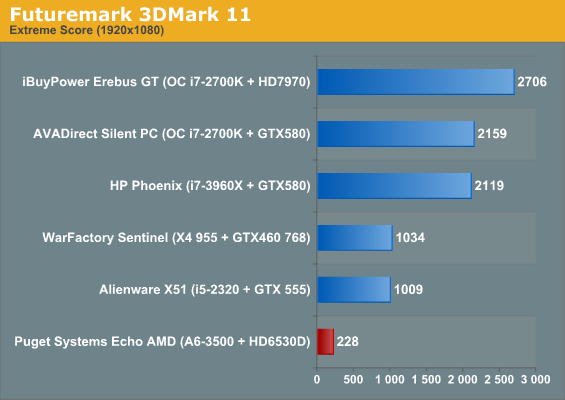


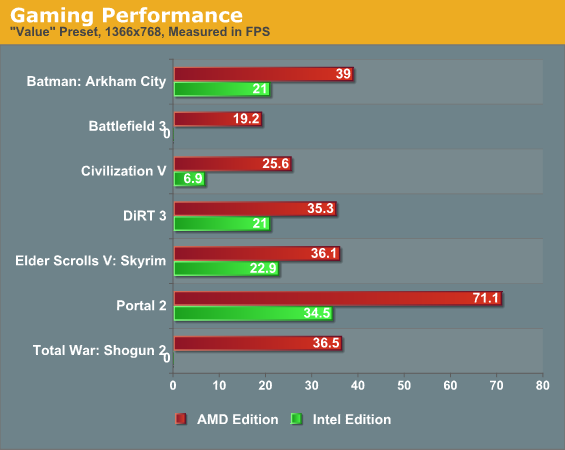
The Intel Core i7-2600S with its crippled IGP can't even run two of our benchmarks, and only produces playable performance in one of them: Portal 2, with its ancient (albeit updated) Source engine. Meanwhile, the Radeon HD 6530D inside the A6-3500 can stretch its legs and deliver playable performance across every game except Battlefield 3, where a dip in resolution or settings will render that game playable as well.
Granted, these are conservative settings at a relatively low resolution, but the point remains that if someone wants to play a game on the A6-3500, they can, and reasonably comfortably. I've seen someone suddenly decide they want to try and play a game only to discover their system's integrated graphics can't handle it at all, and forums are rife with threads of people asking how to upgrade the graphics of their cheap desktops or their notebooks being met with the same answer: "you're screwed." With larger desktop systems, it's a different matter, but for mini-ITX and laptops you have to be prepared to live with whatever graphics the system includes from the factory.










62 Comments
View All Comments
ggathagan - Wednesday, March 21, 2012 - link
As mentioned in the article:"Puget hasn't qualified any 8GB DDR3-1600 DIMMs for deployment in any of their builds, and so they erred on memory capacity instead of speed. In conversations via e-mail, they even admitted this was probably a mistake in this instance. The problem is that they also don't offer any 2GB or 4GB DDR3-1600 DIMMs for the AMD-based system, either, when they do have 4GB DDR3-1600 DIMMs qualified for other builds."
compcons - Wednesday, March 21, 2012 - link
Although I am not claiming a bias, it is a real shame you had to test that Llano with crappy 1333. Although I wouldn't recoomend rolling your own system to run in this silly race, I think it would be very enlightening to see how this would do with fast RAM (1800). I myself was really dissappointed after reading how crappy the AMD did in the CPU tests until I got to the end of the article and realized it was slow RAM. Not o be too harsh, but based on the price and poorly conceived system configuration, I'd tend to not buy anything form these guys...EH
JKflipflop98 - Monday, March 26, 2012 - link
I would be very interested in a future update to the article testing if swapping out the memory modules actually do make that big of a difference.There's only one way to find out. . .
Andrew.a.cunningham - Wednesday, March 21, 2012 - link
Ditto on my end. These endless accusations of bias and/or corruption devalue hours of work on the part of writers and prevents the reasonable discussions that AT commenters are more than capable of having.Andrew.a.cunningham - Wednesday, March 21, 2012 - link
...and these comments are on an article that actually recommends the AMD system over Intel's. :-)ImSpartacus - Wednesday, March 21, 2012 - link
While I cannot disagree with the content of this post, might I suggest that Anandtech staff not respond to critical (errr trolling) comments?I come to Anandtech for a cold and completely objective look at the consumer technology of today and tomorrow.
Sometimes, it isn't possible to hold an objective discussion with commenters. Impassioned (albeit respectful and 'correct') comments can slowly damage the image of a journalist and their distribution channel.
If this site starts falling apart, I won't have anywhere to go. Can we nip this in the bud?
Tchamber - Wednesday, March 21, 2012 - link
Availablility is the issue, they even mentioned that in the article. What mainstream, trusted website were you going to pick that 65w A6 3600 at?BSMonitor - Wednesday, March 21, 2012 - link
Clearly Puget is going for two different market segments with each system. It makes perfect sense to me.The Core i7-2600S is $100 more expensive than the Intel Core i5-2405S, but comes with half the graphics computing power. They simple chose the best CPU performance they could fit in 65W. It would make no sense to have two identical product lines with the only difference for the customer to choose AMD or Intel. So the AMD side is left for the best iGPU performance at hand.
On one line, they are going for low end gaming. On the other, raw computing power. Intel vs AMD is superficial to them. With the mini-gaming rig they also make more $$ as the APU costs $150-70 less.
And please, don't make me laugh.. You could dump 20 Llano cores into the thing and it wouldn't touch Sandy Bridge quad cores. Grow up.
jgutz20 - Wednesday, March 21, 2012 - link
That is true about the AMD cpu used is far from its best, And while the AMD chip has the best GPU of the 2, I'd like to see a "slower" intel chip, be it a i3 or an i5, whatever they have within power envelope that has the HD3000 graphics as that would even the playing field a bit more.I guess what i would like to see is Anandtech re-doing this comparison but with their own build so as to ensure they get the best parts available, not the best parts this company offers in this form factor. Get the MB/CPU/RAM for each setup and re-use the case, HDD's etc.
That is what i would like to see as a follow up to this article!
medi01 - Wednesday, March 21, 2012 - link
At least they couldn't test low power AMD CPU with 1000 watt PSU this time, lol...PS
1500$ for these, you must be kidding me...